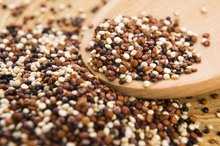Can I Tell What the Glycemic Index Is by Reading a Food Label?
Following a low-glycemic-index diet may help people with diabetes better control their blood sugar levels, according to an article published in "The Review of Diabetic Studies" in 2006. This can be a bit difficult, because food labels in the United States don't list a food's glycemic index score. You can, however, get an idea of which foods may have lower glycemic index scores by looking at the information on the label.
Carbohydrate Content
The glycemic index score indicates how quickly and how much the carbohydrates in a food are likely to increase your blood sugar levels. Foods that have a higher carbohydrate content per serving will have more of an effect on blood sugar levels than those with only a small amount of carbohydrates. The source of the carbohydrates in the food is particularly important, because foods that contain more processed versions of carbohydrates have a greater effect on blood sugar levels than those from whole foods. This means foods made with flour or sugars often have a higher glycemic index than foods made with intact whole grains.
Fiber Content
Glycemic Index of Cheerios
Learn More
Foods higher in fiber, especially soluble fiber, tend to have lower glycemic index scores than those that have little or no fiber. Fiber slows down the digestion of food and thus the release of sugars into the bloodstream, resulting in a slower and smaller increase in blood sugar and a lower glycemic index.
Protein and Fat Content
Protein and fat don't have much of an impact on your blood sugar levels, which means foods that contain a higher ratio of protein and fat to carbohydrates tend to have lower glycemic index scores. Likewise, eating a high-GI food along with a source of protein and fat can decrease the overall GI of your meal.
Other Considerations
Can Carrots Raise Your Blood Sugar?
Learn More
Some foods low on the glycemic index aren't particularly healthy, such as those high in fat. According to an article published in "The British Journal of Nutrition" in January 2014, listing glycemic index scores on food labels will only be beneficial if people understand that eating larger amounts of a low-GI food will increase blood sugar and that the preparation method and what you eat with carbohydrate-containing foods affect their GI score. For example, longer cooking tends to produce higher GI scores. Another article, published in "Nutrition Reviews" in April 2011, suggests that it may be a good idea to require foods to meet certain nutrition standards before being allowed to have a GI label. Otherwise, makers of unhealthy foods might alter their composition to lower their GI and then claim them as healthy because they have a low GI.
Related Articles
References
- The Review of Diabetic Studies: Can the Glycemic Index (GI) be Used as a Tool in the Prevention and Management of Type 2 Diabetes?
- The British Journal of Nutrition: Glycaemic Index: Did Health Canada Get It Wrong? Position From the International Carbohydrate Quality Consortium (ICQC)
- Nutrition Reviews: Informing Food Choices and Health Outcomes By the Use of the Dietary Glycemic Index
- Clinical Diabetes: The 3 R's of Glycemic Index: Recommendations, Research, and the Real World
Writer Bio
Based in Massachusetts, Jessica Bruso has been writing since 2008. She holds a master of science degree in food policy and applied nutrition and a bachelor of arts degree in international relations, both from Tufts University.









